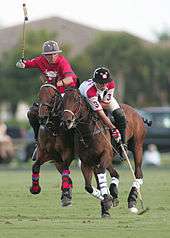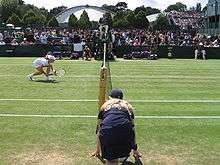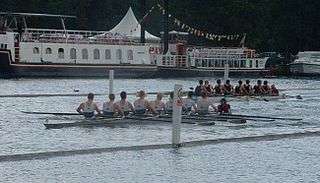Season (society)
The social season, or Season, has historically referred to the annual period when it is customary for members of a social elite of society to hold debutante balls, dinner parties and large charity events. It was also the appropriate time to be resident in the city rather than in the country, in order to attend such events.
The Seasons in London

The London social season evolved in the 17th and 18th centuries, and in its traditional form it peaked in the 19th century. In this era the British elite was dominated by landowning aristocratic and gentry families who generally regarded their country house as their main home, but spent several months of the year in the capital to socialize and to engage in politics. The most exclusive events were held at the town mansions of leading members of the aristocracy. Exclusive public venues such as Almack's played a secondary role. The Season coincided with the sitting of Parliament and began some time after Christmas and ran until midsummer, roughly late June.[1]
The social season also played a role in the political life of the country: the members of the two Houses of Parliament were almost all participants in the season. But the Season also provided an opportunity for the children of marriageable age of the nobility and gentry to be launched into society. Women were formally introduced into society by presentation to the monarch at Court.
The traditional Season went into decline after the First World War, when many aristocratic families gave up their London mansions. From this time on an increasing number of society events took place at public venues, making it harder to maintain social exclusivity.
Many events that take place far from central London came to be regarded as part of the social season, including Royal Ascot and the Henley Royal Regatta. The presentation of débutantes at court was abolished by Queen Elizabeth II in 1958. The events that now constitute the London social Season are increasingly hosted or sponsored by large companies (i.e. "corporate hospitality"). Dress codes still apply to certain events in the season, especially where the Queen plays an official role.
Today there is no official organization of the Season, although most of the traditions and customs remain to this day.
Events in the London Season
According to the peerage guide Debrett's, the traditional social season runs from April to August.[2]
Arts
Glyndebourne — the Proms — Royal Academy Summer Exhibition — West End theatre
Horticulture
Equestrianism
Royal Ascot — the Cheltenham Gold Cup — Badminton — the Grand National — the Royal Windsor Horse Show — the Epsom Derby — Glorious Goodwood
The Crown
Trooping the Colour — the Garter Service
Sport
The Boat Race — Henley Royal Regatta — Polo — Wimbledon — Cowes Week — the Lord's Test Match
Although several of these events are not actually held in London, such as the Hurlingham Polo Cartier International at Guards Polo Club, the organisers of most events attempt to avoid date clashes, so it is generally possible to visit all of them in the same year.
The traditional end of the London Season is the Glorious Twelfth of August, which marks the beginning of the shooting season. Society would retire to the country to shoot birds during the autumn and hunt foxes during the winter, before coming back to London again with the spring.
Dress codes
Many events of the season have traditional expectations with regard to dress.
- At Royal Ascot, for example, hats are a must and to be admitted to the Royal Enclosure for the first time one must either be a guest of a member or be sponsored for membership by a member who has attended at least four times. This continues to maintain a socially exclusive character to the Enclosure. If permitted to enter the Royal Enclosure, gentlemen are required to wear either black or grey morning dress, including a waistcoat, with a top hat. A gentleman may remove his top hat within a restaurant, a private box, a private club or that facility's terrace, balcony or garden. Hats may also be removed within any enclosed external seating area within the Royal Enclosure Garden. Ladies must not show bare midriffs or shoulders and must wear hats.[3]
- At Henley Royal Regatta, in the Stewards' Enclosure gentlemen must wear a jacket and tie. Rowing Club colours on a blazer or cap are encouraged, as is the wearing of boaters. A lady's skirt hem must reach below the knee and is checked before entry by the Stewards' Officers. Hats are encouraged but not required for ladies.[4] When a student protested being denied entry to the Stewards' Enclosure for failing to meet the dress code, saying she had worn the dress "in the Royal Enclosure at Ascot and nobody said anything," a spokesman defended the dress code saying "The intention is to maintain the atmosphere of an English Garden party of the Edwardian period by wearing a more traditional dress."[5] Members must display their enamel badges at all times. Anyone found using a mobile phone is asked to leave immediately and their Stewards' Enclosure host, identified by the number on the guests badge, may have his membership withdrawn as a result.
- At polo matches, it is usual for gentlemen to wear a blazer and always white trousers. Ladies should wear flat shoes, as the tradition of "treading in the divots" precludes wearing heels. The famous Club House at Guards Polo Club in Windsor Great Park is for the use of Club members only, who wear individually made gold and enamel badges. Members' guests are given special gold-embossed tags.
The Season in literature and popular culture
- A London Season features in Jane Austen's Sense and Sensibility and is often a key plot device in Regency romance novels.
- The novel Lucia in London by E. F. Benson is set during the London season in the 1920s.
- Edith Wharton's The Age of Innocence uses the New York social season as a backdrop.
- The novel The Leopard by Giuseppe Tomasi di Lampedusa, and the film by Luchino Visconti, portray the Palermitan season during the Risorgimento.
- Julian Fellowes's novel Past Imperfect takes place during the 1968 Season in London.
- In the 2003 film What a Girl Wants, Lord Henry Dashwood invites his new-found daughter Daphne to attend the London Season.
- The 2009 young-adult novel The Season by Sarah MacLean portrays a young woman entering her first London Season.
- Vincente Minnelli's The Reluctant Debutante
- The British period drama Downton Abbey mostly features the relationships of and between the two eldest daughters of the fictional Earl of Grantham. However, during the course of the series, the outspoken youngest daughter Sybil is presented to society in London. The family are also portrayed to move to London for the duration of the season, returning to their country seat at the end of it. The show's 2013 Christmas Special (set in the summer of 1923) focuses on relative Rose McClare's coming-out ball and presentation to the London society.
- Oscar Wilde's The Picture of Dorian Gray, Lady Windermere's Fan, An Ideal Husband, and The Importance of Being Earnest.
- In Michel Faber's The Crimson Petal and the White, the Season is part and parcel of the plot.
- The Malory-Anderson Family Saga Series of historical romance novels by Johanna Lindsey is set primarily in London, the first one opening up in 1817. Throughout the series, one Season or another, and the balls thrown during them, are mentioned in dialogue, to being central to the plot lines themselves.
- Honoré de Balzac's novel The Muse of the Department contains a description of the London Season:
London is the capital of shops and of speculation, the government is made there. The aristocracy inscribes itself there only during sixty days, it there takes its orders, it inspects the government kitchen, it passes in review its daughters to marry, and equipages to sell, it says good-day and goes away promptly ; - it is so little amusing that it supports itself only for the few days called the season.
Notes
- ↑ 'The Social Character of the Estate: The London Season in 1841′, Survey of London: volume 39: The Grosvenor Estate in Mayfair, Part 1 (General History) (1977), pp. 89-93.
- ↑ "Traditional Season". Debrett's. Retrieved 23 September 2010.
- ↑ "Royal Ascot 14-18th June 2011". Royal Ascot. Retrieved 23 September 2010.
- ↑ Bergin, Olivia (July 1, 2009). "What to wear: Henley Royal Regatta". The Daily Telegraph. London. Retrieved May 23, 2010.
- ↑ Wardrop, Murray (July 2, 2009). "Student falls foul of Henley Royal Regatta dress code wearing Ascot outfit". The Daily Telegraph. London. Retrieved May 23, 2010.
Sources
- Florence Adele Sloane (ed. Louis Auchincloss): Maverick in Mauve: Diary of a Romantic Age, Doubleday, 1983.
- Kate Simon: Fifth Avenue: A Very Social History, Harcourt Brace Jovanovich, 1978.
External links
- The London Season by Michelle Jean Hoppe
- Debrett's Social Season (click 'The Season')
- Late Victorian/Edwardian London Season
- Gilded Age New York social season



